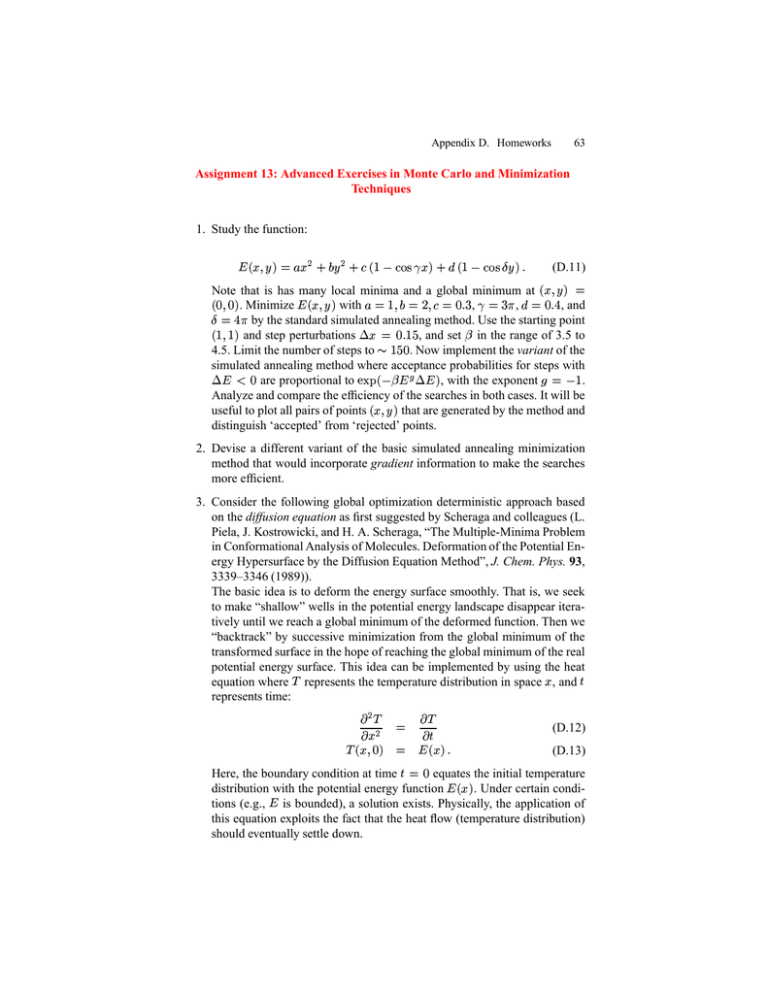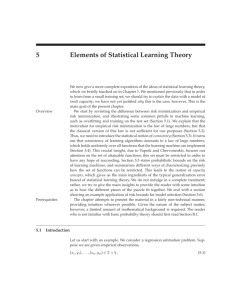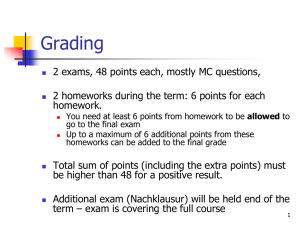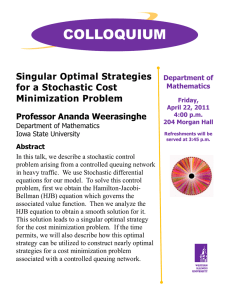Document 11853662
advertisement

Appendix D. Homeworks
63
Assignment 13: Advanced Exercises in Monte Carlo and Minimization
Techniques
1. Study the function:
"!#%$&')(* "!#
+,
&-
(D.11)
.
Note
is has 4
many
local
minima
and
a2
global
minimum
at:/
- ?
0/12/3 .that
'
2
5
6
7
8
9
:
1
/
;
<
$
:
>
;
=
5
(
with
,
,
, and
+@A?= Minimize
by
the
standard
simulated
annealing
method.
Use
the
starting
point
B", and step perturbations C AD/
-EGF , and set H in the range of 3.5 to
GF>/ . Now implement the variant of the
4.5. Limit the number of steps to I
simulated
annealing method where acceptance probabilities for steps with
C KJL/ are proportional to M"N%O B H QP C R , with the exponent S TU .
Analyze and compare the efficiency of the searches in both cases. It will be
'2
that are generated by the method and
useful to plot all pairs of points
distinguish ‘accepted’ from ‘rejected’ points.
2. Devise a different variant of the basic simulated annealing minimization
method that would incorporate gradient information to make the searches
more efficient.
3. Consider the following global optimization deterministic approach based
on the diffusion equation as first suggested by Scheraga and colleagues (L.
Piela, J. Kostrowicki, and H. A. Scheraga, “The Multiple-Minima Problem
in Conformational Analysis of Molecules. Deformation of the Potential Energy Hypersurface by the Diffusion Equation Method”, J. Chem. Phys. 93,
3339–3346 (1989)).
The basic idea is to deform the energy surface smoothly. That is, we seek
to make “shallow” wells in the potential energy landscape disappear iteratively until we reach a global minimum of the deformed function. Then we
“backtrack” by successive minimization from the global minimum of the
transformed surface in the hope of reaching the global minimum of the real
potential energy surface. This idea can be implemented by using the heat
equation where represents the temperature distribution in space , and
represents time:
V
X
XV V 2/Y
X
W
XV
(D.12)
0W &(D.13)
Z
/
Here, the boundary condition at time W
equates the initial temperature
& . Under certain condidistribution with the potential energy function
tions (e.g., is bounded), a solution exists. Physically, the application of
this equation exploits the fact that the heat flow (temperature distribution)
should eventually settle down.
64
Appendix D. Homeworks
0
To formulate this idea, let us for simplicity consider first a one-dimensional
problem where the energy function depends on a scalar . Let
represent the th derivative of
with respect to
and define the
transformation operator on the energy function for as follows:
4 0' H
0&
H
/
(D.14)
That is, we have:
: H :9 H H :); H ); H ..
.
Now writing
we write:
H W
H
H ( ( A
W
where is the time variable, and letting
!
M NO R W 2 ) 9 ; M"NO W ( (> $#
"
..
.
&%
('
%
)%
%
,*
+*
.-/-0- 1
,
-
(D.15)
V W as
V W M NO 2 Q W M"N%O W ( ( &(D.16)
In higher dimensions, let represent the collective vector of indepen( (> by the
dent variables; we replace the differential operator above
Thus we can define
&%
2
X X
-
Laplacian operator, that is
C 4
3 465
2
Using this definition, we can also write
V W V W V W V W X X
V M NO W &7-/-0-
where
4
4
2
X
This definition produces the heat equation (D.12, D.13) since
V W X 4
W
( 9
(W 9
8%
'
'
%
)%
( ;
(W ;
9 8%
9%
%
,*
.-/-0- 1
( (W
(
(> 8%
:-0-/- 1
;
;
X
X V W 0 Appendix D. Homeworks
65
In practice, the diffusion equation method for global optimization is implemented by solving the heat equation by Fourier techniques (easy, for
example, if we have dihedral potentials only) or by solving for up to
a sufficiently large time . This solution, or approximate solution (representing
for some large ), is expected to yield a deformed surface
with one (global) minimum. With a local minimization algorithm, we compute the global minimum
of the deformed surface, and then begin an
iterative deformation/minimization procedure from
and
so that
at each step we deform backwards the potential energy surface and
obtain
and
its associated global minimum (
-0-/to ,
and to ,
). Of
course, depending on how the backtracking is performed, different final
solutions can be obtained.
W 0' W CRW V
W
W
4
W 9 RC W W W W 0CR'2W /3 (a) To experiment with this interesting diffusion-equation approach for
global minimization, derive a general form for the deformation oper
on the following special functions
:
ator
(i) polynomial functions of degree , and (ii) trigonometric functions
and , where is a real-valued number (frequency). What
is the significance of your result for (ii)?
(b) Apply the deformation operator
=
to the quadratic
function
&
V W M NO W ( >( V W M NO W ( (> 4A 3 )
(D.17)
;
<
B0
and
. Evaluate and plot your resulting V W
with
/
9
"
E
function at W
CRW CRW , for small time increments CQW until the
global minimum is obtained.
(c) Apply the deformation operator V W for the two-variable function
in eq. (D.11). Examine behavior of the deformation as W
as a
function of the constants and . Under what conditions will a unique
?
minimum be obtained as W
4. Use Newton minimization to find the minimum of the two-variable function in equation (D.11) and the one-variable function in equation (D.17).
It is sufficient for the line search to use simple bisection: ,
etc., or some other simple backtracking strategy. For the quartic function,
experiment with various starting points.
>
/1- F





